Home Decor
How Much Is Interior Decorating
Hungry to know how much interior decorating costs? Dive into the average expenses, designer fees, and key considerations for your next project.

Interior decorating costs typically range from $2,000 to $12,000 on average, factoring in designer fees, project scope, and location influences. Expenses can include $50 to $500 per hour for designers, with flat fees for online services ranging from $79 to $1849. The impact of space size on costs and the importance of setting a clear budget are key considerations. Understanding these components can guide your decision-making process when starting on an interior decorating project. Discover more about factors influencing prices, decorator versus designer fees, and cost-effective design tips for informed choices.
Key Takeaways
- Costs range from $2,000 to $12,000.
- Designer fees vary from $50 to $500 per hour.
- Online services offer flat fees from $79 to $1849.
- Space size impacts overall expenses.
- Clear budgeting is crucial for effective planning.
Average Interior Decorating Costs
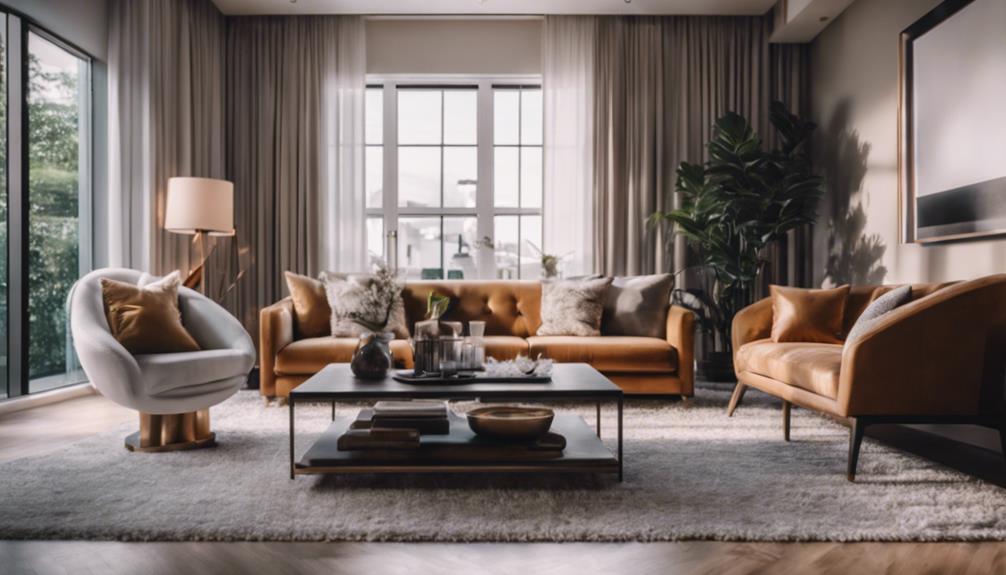
When considering interior decorating costs, it's important to keep in mind that the average range can vary significantly depending on various factors such as project scope and space size. The average cost of interior decorating falls between $2,000 to $12,000, making it essential to establish a clear budget from the outset.
Hiring an interior designer can also impact costs, as their fees can range from $50 to $500 per hour. For those seeking more cost-effective options, online interior design services offer flat fees ranging from $79 to $1849, providing a more affordable alternative.
Additionally, the size of the interior space plays a significant role in determining costs, as larger spaces often require more materials and labor, thereby increasing the overall expenses. Understanding these average costs and the various factors that influence them is key to planning an interior decorating project that aligns with both your vision and budget.
Scope of Interior Decorating Projects
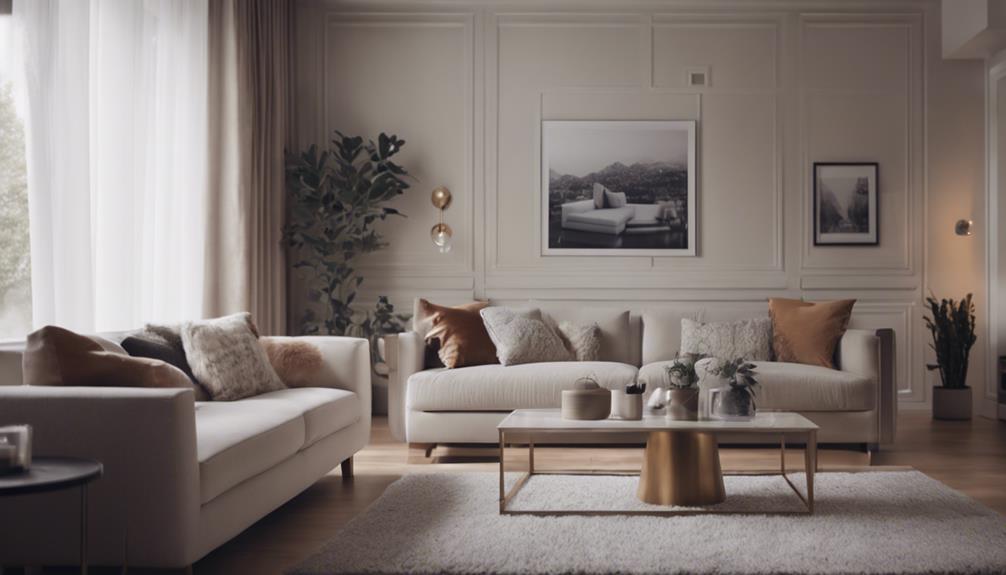
Interior decorating projects typically focus on enhancing aesthetics, color schemes, furniture arrangement, and decor selection.
Whether you're looking to revamp a single room or your entire home, interior designers can work with you to create a cohesive look that reflects your style and preferences. These professionals specialize in transforming spaces without the need for major structural changes, focusing on elements like furniture placement, color coordination, and accessory selection.
When considering an interior design project, costs can vary depending on factors such as the experience of the designer, the complexity of the project, and the location of your space. Hiring a professional decorator can be a worthwhile investment, as they've the expertise to bring your vision to life while ensuring that the final result is both visually appealing and functional.
From selecting furniture pieces to choosing the perfect color schemes, interior decorators play an essential role in elevating the aesthetic appeal of any room.
Factors Influencing Decorating Prices

Factors influencing decorating prices can vary depending on the scope of the project, designer expertise, and chosen design elements. Interior designers charge based on various factors, including their design skills and the complexity of design elements involved.
Material costs also play a significant role in determining the overall expenses of a decorating project. The scope of the project, such as the size of the space being decorated, can impact pricing, with larger areas often requiring more resources and time.
Additionally, project management services, along with installation and styling, may incur extra charges. When hiring a professional for interior decorating, it's important to take into account not only the design fees but also potential additional costs like material expenses and any supplementary services needed.
Location can also influence decorating prices, as urban areas typically have higher costs due to increased demand and operational expenses. Understanding these factors can help in budgeting effectively for a decorating project.
Interior Decorator Vs. Designer Fees
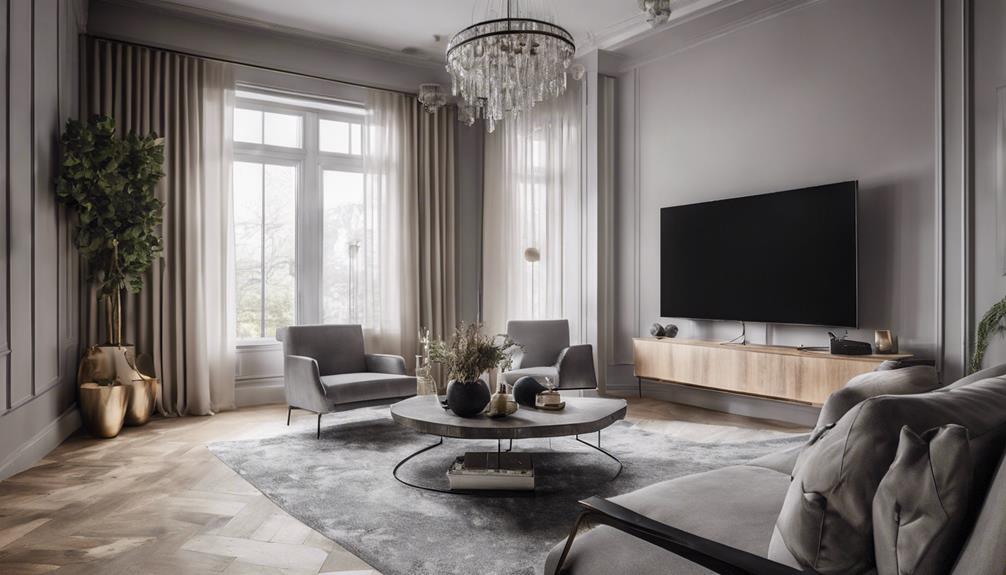
When considering whether to hire an interior decorator or designer, it's important to understand the cost differences between the two professions.
Interior decorators generally charge lower fees, focusing on aesthetics and decor choices, while interior designers command higher rates due to their formal education and broader scope of work.
Understanding these fee variations can help you determine the value of expertise needed for your project and make an informed decision based on your specific needs and budget.
Cost Differences Explained
Given the complexity of design projects, it's clear that the cost disparity between interior decorators and designers stems from their distinct areas of expertise and services offered. Here are some key points to help comprehend the differences in fees:
- Scope of Services: Interior decorators focus on aesthetics, while professional interior designers offer a broader range of interior design services.
- Hourly Rates: Decorators generally charge $50 to $200 per hour, whereas designers may command $100 to $500 per hour.
- Project Costs: Designer charges are higher due to considerations like functionality, space planning, and compliance.
- Project Size: Larger residential projects often necessitate the expertise of interior designers, impacting overall project costs.
Factors Influencing Fees
In comparing the fees charged by interior decorators and designers, it becomes evident that the expertise and services offered play an essential role in determining the cost differences. Interior designers, with their formal education and years of experience, often charge higher fees due to the thorough design help they provide. They can assist with project scope, offer design solutions, and manage the entire process, leading to a higher total cost.
On the other hand, interior decorators may charge per room and base their fees on the amount of time spent, the project's complexity, and the client's requirements. Factors such as the size of the project and the level of design assistance needed are important in deciding between hiring a designer or a decorator.
Value of Expertise
From our research, it's evident that the value of expertise greatly impacts the fees charged by interior decorators and designers. When considering hiring an interior designer, here are some key points to keep in mind:
- Houston Interior Designer: Location can influence pricing, with major cities like New York often having higher rates.
- Charge per room: Some designers may offer flat fees per room, while others charge hourly rates.
- Designers can help: Their expertise goes beyond aesthetics to include functionality, space planning, and adherence to building codes.
- Make your home look: Investing in professional help can enhance your interior style, ultimately adding value to your home and saving you time in the long run.
Hourly Rates for Interior Decorating

To guarantee transparency, it's essential to mention that hourly rates for interior decorating typically range anywhere between $50 and $200 per hour. These rates can vary based on factors such as the scope of the project and the experience level of the decorator. Some decorators may opt for flat fees per room or project instead of charging by the hour. Interior decorating costs are distinct from furniture or decor expenses, which are additional to the designer's fees.
When considering hiring an interior decorator, you should inquire about their pricing structure. Some decorators may offer package deals or fixed rates for specific design projects, which could potentially save you money in the long run. Understanding the hourly rates and any additional fees associated with the services provided will help you budget effectively for your interior decorating project. By discussing pricing upfront and clarifying all costs involved, you can establish a transparent and satisfactory working relationship with your decorator.
Flat-Rate Pricing for Decorators
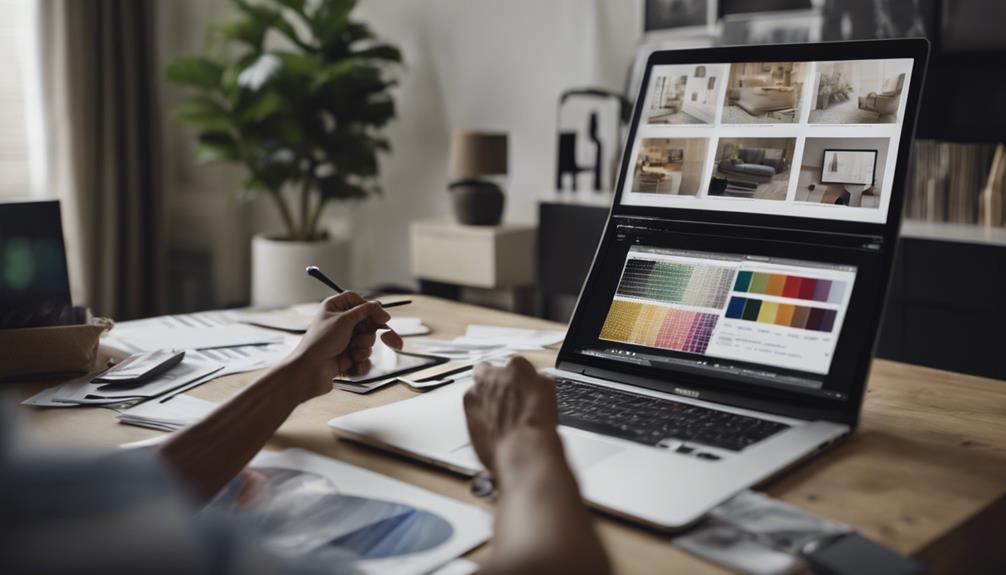
When contemplating interior decorating services, exploring flat-rate pricing for decorators can provide a clear budget upfront and eliminate hourly charges. This pricing model offers a fixed fee for the entire project, making it easier to understand the costs involved right from the start.
Here are some key points to contemplate when opting for flat-rate pricing:
- Range of Pricing: Flat-rate pricing for interior decorators typically varies from $500 to $5,000 for a complete design project.
- Suitability: This pricing structure is popular for smaller projects or when clients prefer a clear budget at the outset.
- Cost Factors: The total cost can depend on factors like the complexity of the design, size of the space, and the decorator's experience.
- Elimination of Hourly Charges: Flat-rate pricing eliminates the uncertainty of hourly charges, allowing clients to plan and budget effectively for their interior decorating needs.
Location Impact on Decorating Costs
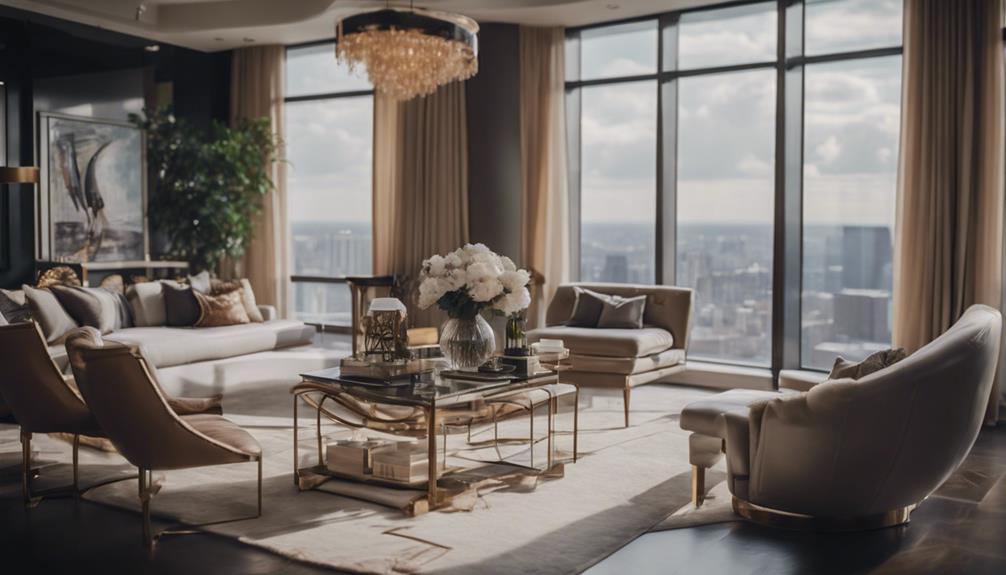
Considering the impact of location on decorating costs provides valuable insight into the pricing dynamics of interior decorating services. Interior decorating costs can vary substantially between urban areas and rural areas due to factors such as cost of living, competition, and demand.
In cities like New York and Los Angeles, where the cost of living is higher and competition among decorators is fierce, clients may expect to pay more for interior decorating services compared to smaller towns with lower living expenses. Market trends and regional differences also play an important role in determining pricing, as the availability of resources and the overall demand for decorating services can fluctuate based on location.
Understanding these regional variations in pricing is essential for clients to effectively budget for interior decorating projects and make sure they're getting the best value for their money. By staying informed about the market trends and cost factors in different locations, clients can make more informed decisions when hiring interior decorators.
Tips for Budget-Friendly Interior Design
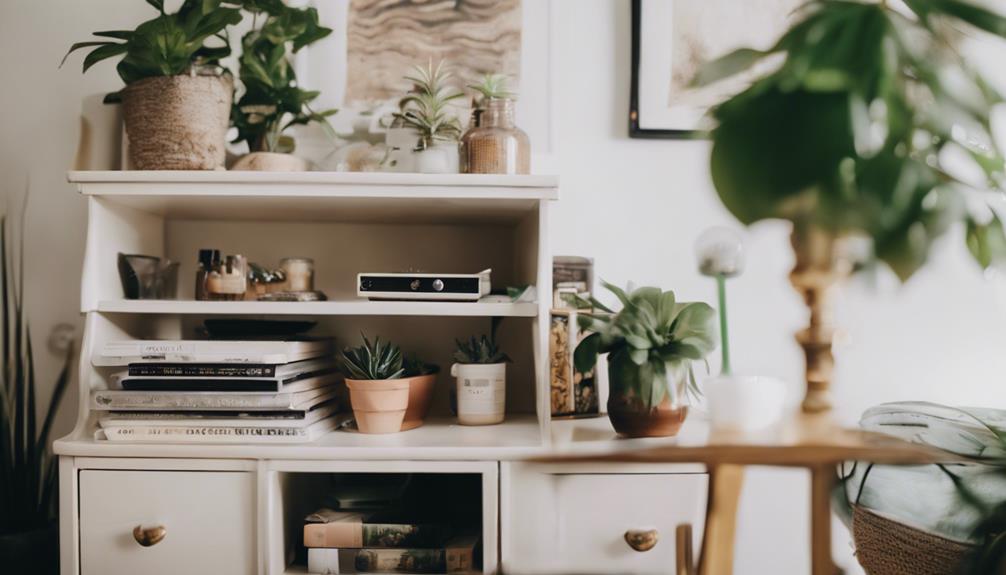
In order to achieve budget-friendly interior design, it's important to explore cost-effective options and strategies that can help minimize expenses while still achieving the desired aesthetic.
Here are some tips to help you achieve a stylish interior without breaking the bank:
- Set a clear budget: Establishing a budget is the first step in managing interior decorating costs effectively.
- Consider DIY projects: Taking on do-it-yourself projects can save you money on labor costs and add a personal touch to your space.
- Shop for furnishings wisely: Look for sales, discounts, and second-hand options to find affordable yet stylish furniture and decor pieces.
- Hire a junior designer or design student: Opting for the services of a less experienced professional can be a cost-effective way to get expert advice and assistance without the high price tag of a seasoned designer.
Frequently Asked Questions
How Much Should I Budget for an Interior Decorator?
When budgeting for an interior decorator, it's important to take into account the project's scope and intricacy. Costs can range from $1,000 to $50,000, influenced by hourly rates typically between $50 to $200.
Flat-rate pricing models are common, ensuring transparent fee structures. Remember, additional expenses for materials and furnishings are separate.
The final cost hinges on project complexity, design preferences, and the decorator's expertise. So, plan accordingly based on these factors.
How Much Should You Charge for Decorating?
Taking into account decorating can be a bit tricky. Factors such as project scope, designer's experience, and location influence rates. Hourly fees range from $50 to $200, with flat rates starting around $200 for small projects.
Additional expenses for materials, furnishings, and decor are usually separate. Quotes may include labor, materials, project breakdown, and cleanup, but often exclude permits and contractor fees.
It's important to ponder all aspects before setting a final price.
How Much Does It Cost to Decorate Your Room?
Decorating a room can range from $500 to $5,000 depending on size and complexity. Interior decorators charge $50 to $200 per hour plus fees for materials and furnishings. Some offer packages starting at $299 to $999, inclusive of consultations and concept boards.
DIY decorating may cost $100 to $1,000 for decor items and paint. Online services like Havenly provide room design options starting at $79.
Is It Worth Getting Interior Decorator?
Getting an interior decorator can be worth it for those seeking professional guidance on decor choices and layout optimization. They focus on aesthetics and style preferences to enhance a space's visual appeal.
Interior decorators are more budget-friendly than interior designers, averaging $50 to $200 per hour. They help clients achieve a cohesive and visually appealing design within a specified budget.
It's a practical investment for a harmonious and stylish living environment.
Conclusion
To sum up, when contemplating interior decorating costs, it's crucial to take into account the scope of the project, location, and other influencing factors. It's essential to factor in both hourly rates and flat-rate pricing when planning for your decorating needs.
By familiarizing yourself with the average costs and strategies for budget-friendly design, you can make informed decisions and craft a beautiful space within your desired budget. Keep in mind that with careful planning and research, reaching your interior decorating goals is possible without exceeding your budget.
Home Decor
Creative Bird Nest Decorating Ideas: 7 Inspirations
Witness the transformation of ordinary bird nests into extraordinary works of art with these 7 creative and inspirational decorating ideas.

Transforming a bird's nest into a work of art has never been easier! You'll find inspiration in natural elements like moss and pebbles, or vibrant floral embellishments that add a pop of color. Whimsical textures from twine and ribbon accents can also elevate your design. For a rustic touch, incorporate earthy stone and pebble decorations or rustic pinecone and acorn accents. Delicate twig and branch creations can add a touch of elegance, while colorful fabric and yarn wraps can add a playful vibe. Explore these creative bird nest decorating ideas and uncover more innovative ways to make your nest a masterpiece.
Key Takeaways
• Incorporate nature-inspired elements like moss, pebbles, and twigs to create a whimsical and earthy ambiance in your bird nest decor.
• Use vibrant floral embellishments, such as real or artificial petals, to add a pop of color and elegance to your bird nest.
• Add a rustic touch with earthy stone and pebble decorations, which provide a unique textured contrast to softer materials.
• Customize your bird nest with yarn wraps and fabric-wrapped delights that match your home decor or the bird's plumage, adding a soft and cozy texture.
• Mix and match different materials, such as twine, ribbon, and fabric, to create a visually stunning and personalized bird nest that reflects your style.
Whimsical Twine and Ribbon Accents
Wrap twine and ribbon accents around your bird nest to infuse a touch of whimsy and rustic charm into your home decor. This simple yet effective technique can instantly elevate your bird nest decorations, adding a unique personality to your space.
As you experiment with different colors and textures of twine and ribbon, you'll discover that each combination creates a one-of-a-kind aesthetic. Feel free to mix and match twine and ribbon accents to enhance the overall look of your bird nest decor.
The best part? These accents can be easily adjusted or changed to match different seasons or themes in your home decor. For instance, you can swap out a vibrant ribbon for a more muted tone to shift from summer to fall.
Nature-Inspired Moss and Leaf Designs

As you explore the world of nature-inspired moss and leaf designs, you'll discover a trio of exciting possibilities to elevate your bird nest decor.
You can recreate the serene ambiance of a mossy forest floor, layer leaves to mimic a lush canopy, or incorporate earthy textured accents to bring the outdoors in.
These unique designs will add a touch of organic charm to your bird nest, and we're about to explore each of these points in more detail.
Mossy Forest Floor
By incorporating natural elements like moss and leaves into your decor, you can transport the serene ambiance of a mossy forest floor directly into your home. This decor style brings a touch of the outdoors inside, creating a serene and earthy ambiance. Moss and leaf designs add texture and depth to the overall aesthetic, enhancing the visual appeal of the space.
To incorporate mossy forest floor elements into your bird nest decor, consider the following ideas:
| Decor Piece | Mossy Forest Floor Element | Benefit |
|---|---|---|
| Wall Art | Moss-covered canvas | Adds texture and earthy tone |
| Table Centerpiece | Leaf-adorned vase | Creates a natural, whimsical feel |
| Bird Nest | Moss-lined nest | Evokes a sense of tranquility |
| Shelf Decoration | Leaf-shaped decorative piece | Adds a touch of the outdoors |
Leafy Canopy Layers
You can create a lush, immersive atmosphere in your bird nest decor by incorporating leafy canopy layers that mimic the intricate structures of real bird nests. By incorporating natural elements like moss, leaves, and branches, you can add texture and depth to your decorations, evoking the cozy and intricate structures of birds' nests.
These nature-inspired designs bring a touch of the outdoors inside, creating a serene and peaceful ambiance in any space. The versatility of leafy canopy designs allows them to blend seamlessly with various decor styles, from rustic to modern.
As you design your bird nest decor, consider incorporating layers of greenery like moss and leaves to evoke a sense of tranquility and connection to nature. By doing so, you'll create a space that not only celebrates the beauty of nature but also invites relaxation and calmness.
With leafy canopy layers, you can transport the serene atmosphere of the outdoors into your home, creating a unique and mesmerizing bird nest decor that's sure to impress.
Earthy Textured Accents
Incorporating earthy textured accents like moss and leaf designs into your bird nest decor brings an organic, natural charm to your space. These elements add a touch of the outdoors to your decor, creating a cozy and inviting atmosphere reminiscent of a real bird's nest.
By incorporating moss and leaves into your design, you'll create a serene and calming environment that's perfect for relaxation.
Here are a few ways to incorporate earthy textured accents into your bird nest decor:
- Add a moss-covered wreath or garland to your walls or mantel to bring in a touch of nature
- Use artificial leaves in shades of green and brown to create a lush, forest-inspired look
- Incorporate natural elements like pinecones, acorns, or twigs into your decor to add depth and dimension
Vibrant Flower Petal Embellishments
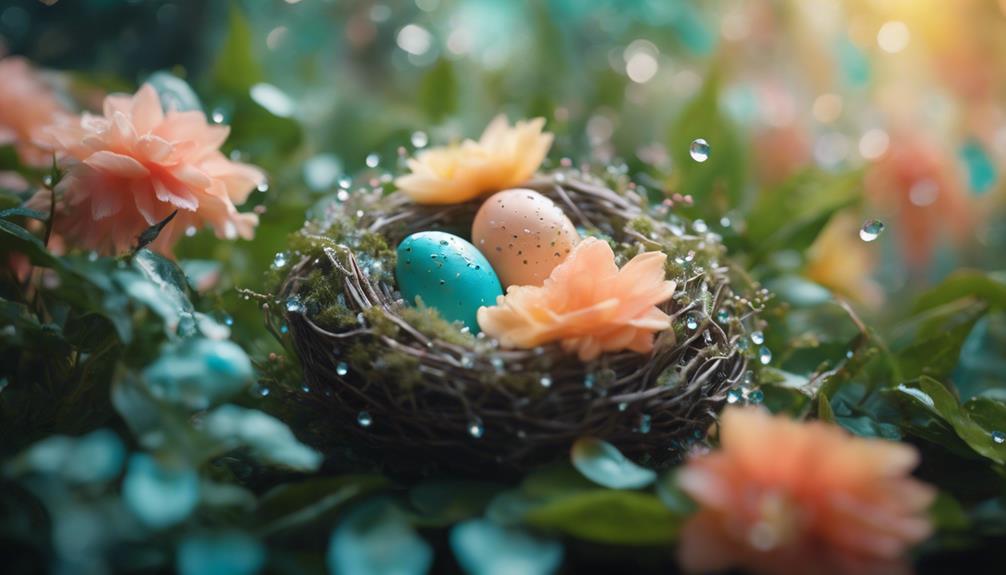
Add a splash of vibrancy to your bird nest with vibrant flower petal embellishments, which inject a pop of color and texture into your design. You can choose from a variety of options, including real or artificial petals, to customize your Bird's Nest.
Dried flower petals provide a long-lasting and fragrant decoration, while silk flower petals create a realistic and durable embellishment for your nest. Mixing different flower colors and types can create a visually stunning nest design. For instance, you can combine delicate pastel shades with bold, bright hues to create a unique look.
Alternatively, you can stick to a single color scheme to achieve a cohesive design. Whatever your preference, vibrant flower petal embellishments are sure to add a touch of elegance to your bird nest. With so many options available, you can experiment with different styles and designs to create a one-of-a-kind bird's nest that reflects your personal taste.
Earthy Stone and Pebble Decorations
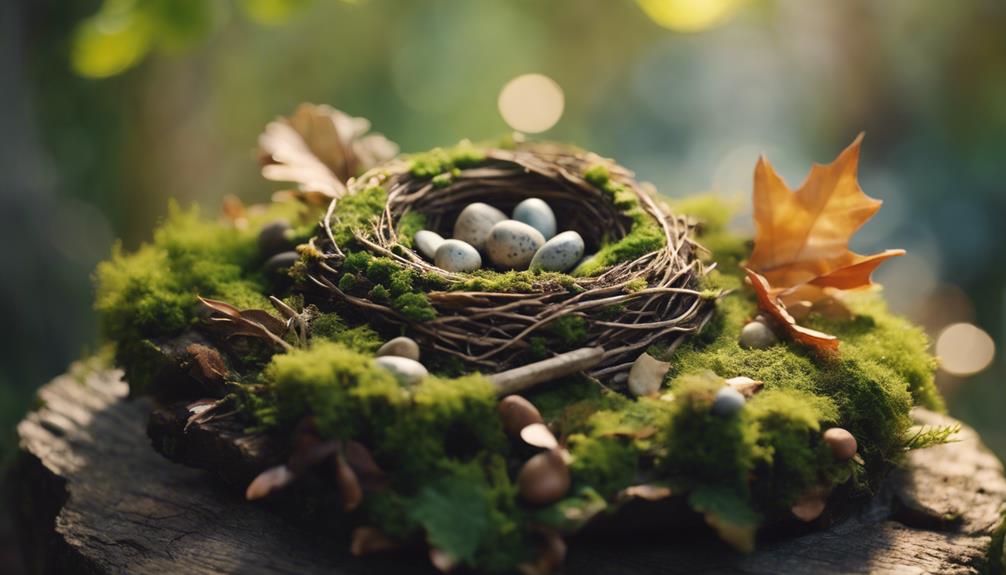
Stones and pebbles bring an organic charm to your bird nest, effortlessly blending with its natural surroundings. By incorporating these earthy elements, you'll create a unique and rustic bird's nest that resonates with the outdoors.
Here are a few ways to incorporate stones and pebbles into your bird nest design:
- Use small stones or pebbles to line the bottom of the nest, adding a textured and rustic touch.
- Scatter small stones or pebbles around the nest as accents or decorations, creating a visually appealing contrast with softer materials like moss or feathers.
- Incorporate larger stones into the nest structure for added stability and visual interest, adding depth and dimension to your design.
Delicate Twig and Branch Creations
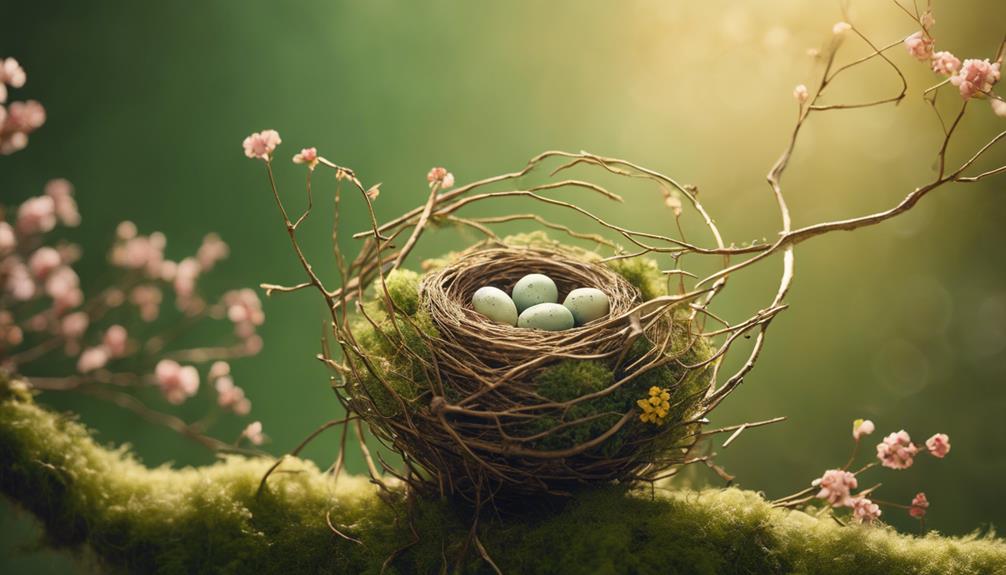
As you weave together delicate twigs and branches, you'll create a bird nest that exudes rustic charm and whimsy. These handmade bird's nests, often crafted from natural materials like grapevines or pliable branches, showcase intricate weaving and a sturdy structure secured with twine.
To add a touch of coziness, you can fill and line the nest with green or Spanish moss, creating a snug haven for your decorative eggs. For an extra layer of beauty, dried flowers and other embellishments can be added to enhance the natural beauty of the nest.
The result is a charming decor piece for your home, which can be displayed with or without eggs. The delicate twig and branch creations evoke a sense of rustic elegance, making them a perfect addition to any room. By combining natural materials and attention to detail, you'll craft a bird's nest that's both visually striking and full of character.
Colorful Fabric and Yarn Wraps
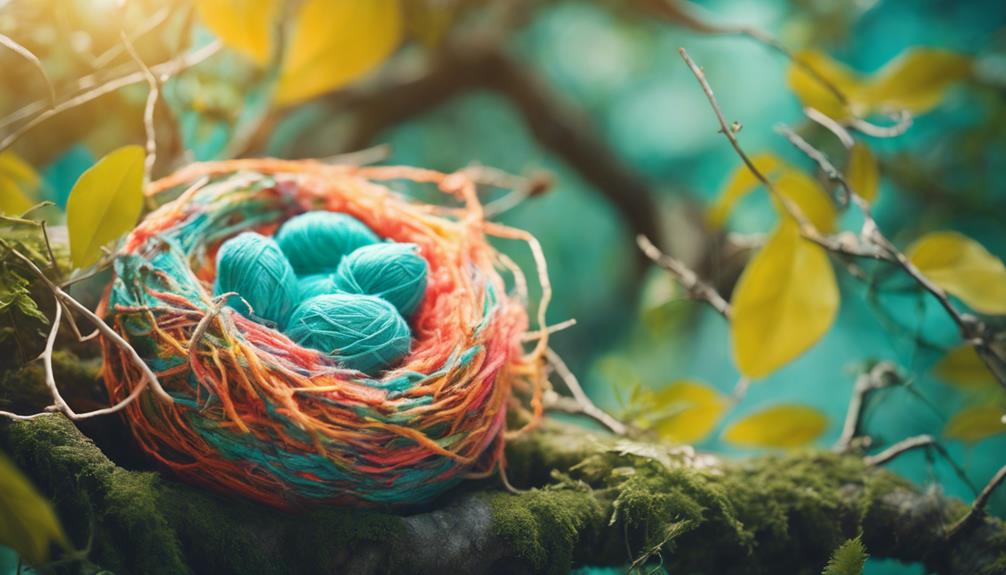
As you explore the world of colorful fabric and yarn wraps, you'll discover a multitude of creative possibilities.
With vibrant yarn accents, you can add a burst of color to your bird nest decoration, while fabric-wrapped delights offer a unique texture and pattern.
Vibrant Yarn Accents
You can instantly elevate your bird nest's aesthetic by incorporating vibrant yarn accents, which add a burst of color and texture to the overall design. This is an excellent way to create a cozy and inviting space for your feathered friends.
By wrapping yarn around the nest, you can add a pop of color and create a unique, personalized touch.
Here are a few benefits of using vibrant yarn accents in your bird nest:
- Customization: You can choose yarn wraps that match your home decor or the birds' plumage, creating a cohesive look.
- Soft and Cozy: Yarn wraps provide a soft, cozy texture that will make your bird nest feel warm and inviting.
- Budget-Friendly: Yarn wraps are a budget-friendly way to decorate your bird nest, allowing you to get creative without breaking the bank.
Fabric Wrapped Delights
By combining yarn wraps with colorful fabric scraps, you can create a visually stunning bird nest that's as unique as it's inviting. This DIY technique allows you to customize the look of your bird's nest, adding a pop of color and texture to your home decor.
With endless creative possibilities, you can mix and match different fabrics to create a one-of-a-kind nest that reflects your personal style. Fabric-wrapped nests are also a budget-friendly and eco-friendly decor option, making them a great choice for those looking to add a touch of whimsy to their space without breaking the bank.
To get started, simply wrap yarn or fabric scraps around the bird's nest, overlapping the strips to create a cohesive look. You can also experiment with different patterns and textures by combining fabrics with varying weights, weaves, and colors. The result is a bird's nest that's as visually striking as it's unique – a true conversation starter in any room.
Cozy Nest Textures
To create a cozy, inviting atmosphere, wrap your bird nest with an assortment of colorful fabrics and yarns. Carefully select textures that evoke the softness of feathers or the warmth of a bird's nest. By incorporating different fabrics and yarns, you can create a unique and playful look that adds depth and visual interest to your bird nest decor.
Some ideas to get you started:
- Mix and match fabrics with varying textures, such as velvet, linen, and cotton, to create a visually appealing combination.
- Use yarn wraps in bold, bright colors to add a pop of color and tactile element to your bird nest decor.
- Experiment with different yarn patterns, such as stripes or polka dots, to add an extra layer of visual interest.
Rustic Pinecone and Acorn Accents
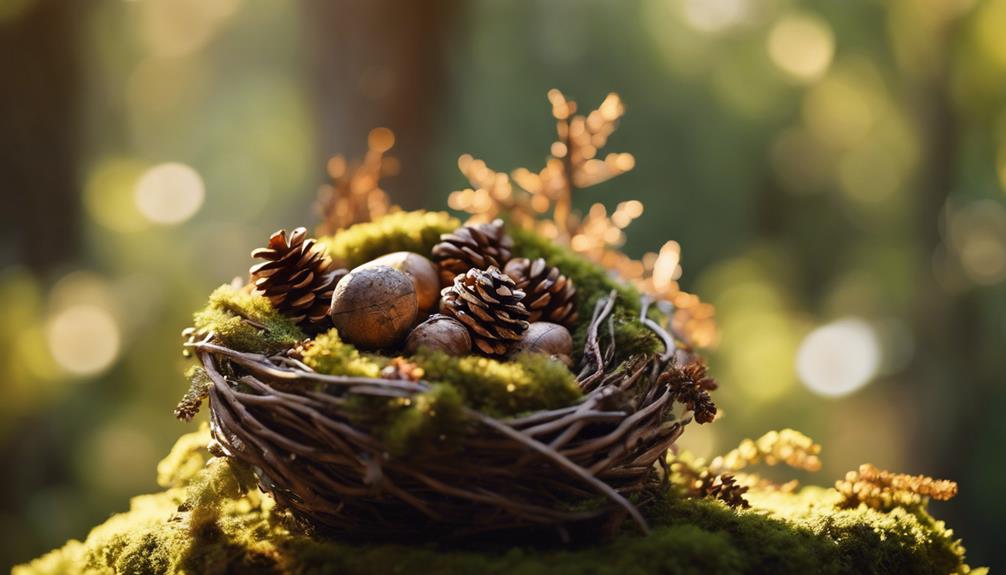
Pinecones and acorns, abundant in forests, bring a touch of rustic charm to bird nest decorations, effortlessly evoking a sense of the great outdoors. You can incorporate these natural elements into your bird nest decor to create a cozy and inviting atmosphere. As symbols of growth and renewal, pinecones are perfect for spring-themed decor, while acorns represent strength and potential, enhancing the symbolism of the bird's nest itself.
When mixing pinecones and acorns with bird nests, you'll create a charming woodland aesthetic that's sure to impress. To get started, simply gather a few pinecones and acorns, and arrange them around your bird's nest in a way that feels natural and organic. You can also add some greenery, like eucalyptus or ferns, to add some extra texture and depth to your design. With these rustic accents, you'll create a bird nest decoration that's both beautiful and meaningful.
Frequently Asked Questions
How to Make a Bird Nest Decor?
To make a bird nest decor, you'll need some key materials. Gather grapevine or pliable branches for the base, and fill it with green and Spanish moss for a realistic look.
Secure the branches with natural jute twine, creating a circular shape. Add dried flowers for a charming touch, and display your finished nest with decorative eggs for a complete spring-inspired look.
How to Make a Model of Birds Nest?
To make a model of a bird's nest, you'll need to gather materials like twigs, moss, feathers, and mud. Start by shaping a grapevine or pliable branches into a circular structure, securing them together to form the nest's base.
Then, weave in layers of moss, feathers, and other materials to mimic a natural bird's nest. Finally, add faux eggs for an authentic touch, and you'll have a realistic model of a bird's nest.
How to Make Nest Art and Craft?
You're about to discover a treasure trove of creativity, as making nest art and craft is a million times more exciting than you think!
To get started, gather materials like twigs, moss, and dried flowers. Begin by creating a base structure with the twigs, then add layers of moss and decorations.
Experiment with different shapes, sizes, and textures to reflect your personal style. With patience and imagination, you'll craft a unique piece that's a true reflection of your artistic vision.
How to Display a Real Bird's Nest?
When displaying a real bird's nest, you'll want to showcase its natural beauty while preserving its delicate structure.
You can place it under a glass cloche, which will protect it from dust and add a touch of elegance.
Alternatively, try hanging it from a door knob using twine for a charming, whimsical look.
Whichever method you choose, be sure to handle the nest gently and avoid exposing it to direct sunlight or moisture.
Conclusion
As you've explored these creative bird nest decorating ideas, you might be wondering: do birds actually decorate their nests? Research suggests that some bird species do exhibit decorative behaviors, like the bowerbird's elaborate courtship displays.
While our decorative ideas are purely for human enjoyment, they do draw inspiration from nature's own artistry. By incorporating natural elements and whimsical touches, you can create a beautiful bird nest decoration that's a true tribute to the wonders of the natural world.
Vivienne – Your Content Companion Vivienne is your content companion, curating valuable tips, advice, and inspiration to guide you on your home decor journey. From insightful blog posts to informative product descriptions, she’s here to empower you with the knowledge you need to create your dream space.
Home Decor
What Are the Different Types of Interior Decorating
Discover the diverse array of interior decorating styles, from Traditional to Modern, each offering unique design elements to transform your living spaces.
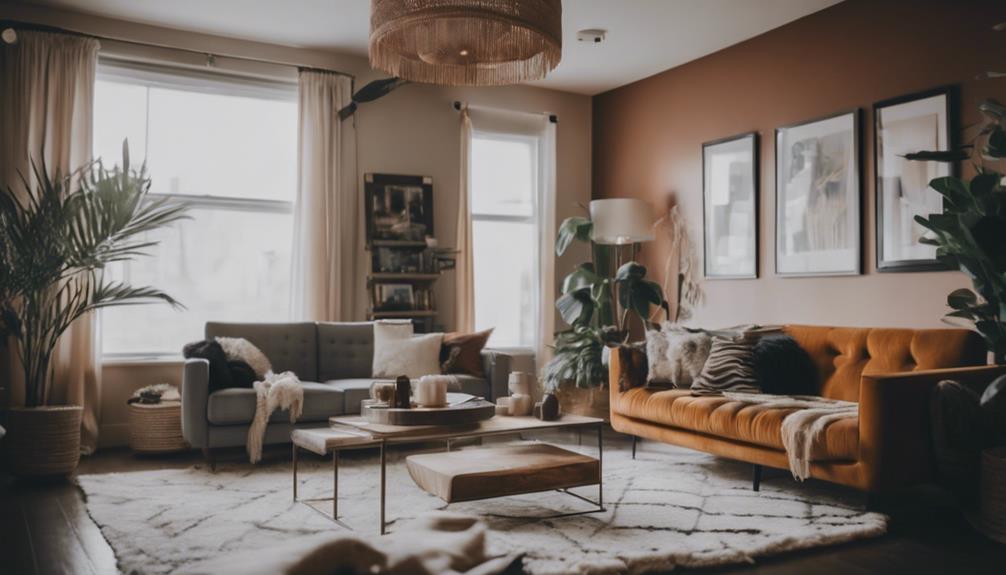
There are various types of interior decorating styles to suit different tastes and preferences. Styles include Traditional for a classic and elegant look with rich colors, Modern for simplicity and eco-friendliness, Industrial with rugged aesthetics using raw materials, Minimalist emphasizing calm and decluttered spaces, Bohemian for vibrant and free-spirited designs, Beach-Inspired evoking coastal vibes, Nautical featuring maritime elements, Seaside for a relaxed coastal feel, Eclectic for uniqueness and customization, and Contemporary balancing functionality and aesthetics beautifully. Each style offers distinct features and design elements to create diverse atmospheres within your living spaces.
Key Takeaways
- Traditional interior decorating exudes elegance with rich colors and ornate details.
- Modern interior decorating embraces simplicity through clean lines and eco-friendly materials.
- Industrial interior decorating showcases raw materials like metal and wood with salvaged items.
- Minimalist interior decorating focuses on a neutral palette and functionality for a serene atmosphere.
- Bohemian interior decorating blends vibrant hues and eclectic furniture for a free-spirited look.
Traditional Interior Decorating Styles
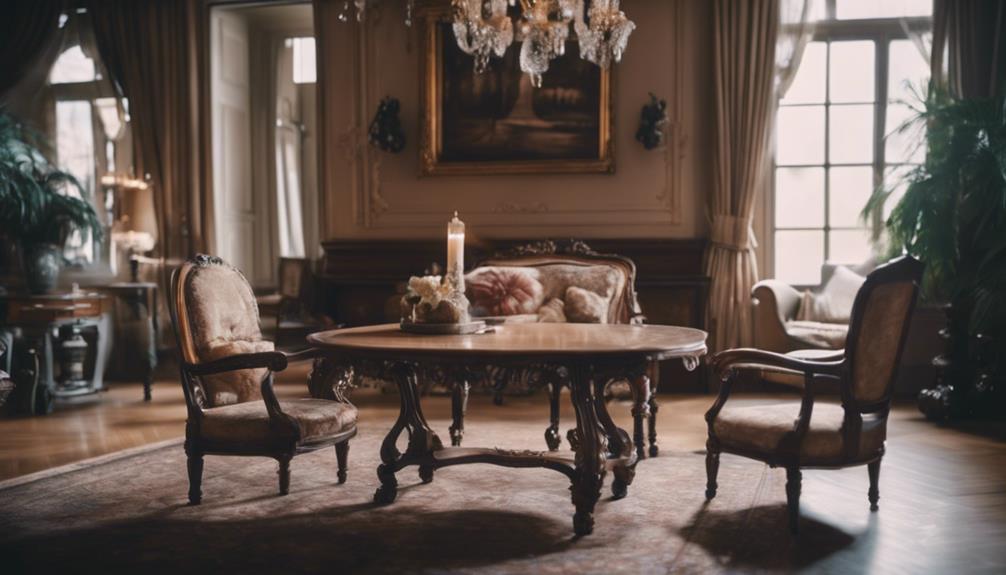
Traditional interior decorating styles embrace classic design elements that exude elegance and timelessness. These styles often incorporate rich colors, ornate details, and formal furniture arrangements to create a sense of luxury and sophistication. Symmetry and balance play an essential role in traditional interior decorating, adding a sense of order and harmony to the space. Comfort is also a key consideration, with plush seating and cozy textures enhancing the overall ambiance.
European influences can be seen throughout traditional interior decorating styles, drawing inspiration from the grandeur and opulence of old-world European design. From intricate moldings to elegant furnishings, these styles reflect a sense of history and tradition. Whether it's a regal Victorian aesthetic or a refined French country look, traditional interior decorating offers a wide range of options for those who appreciate timeless elegance.
Modern Interior Decorating Styles
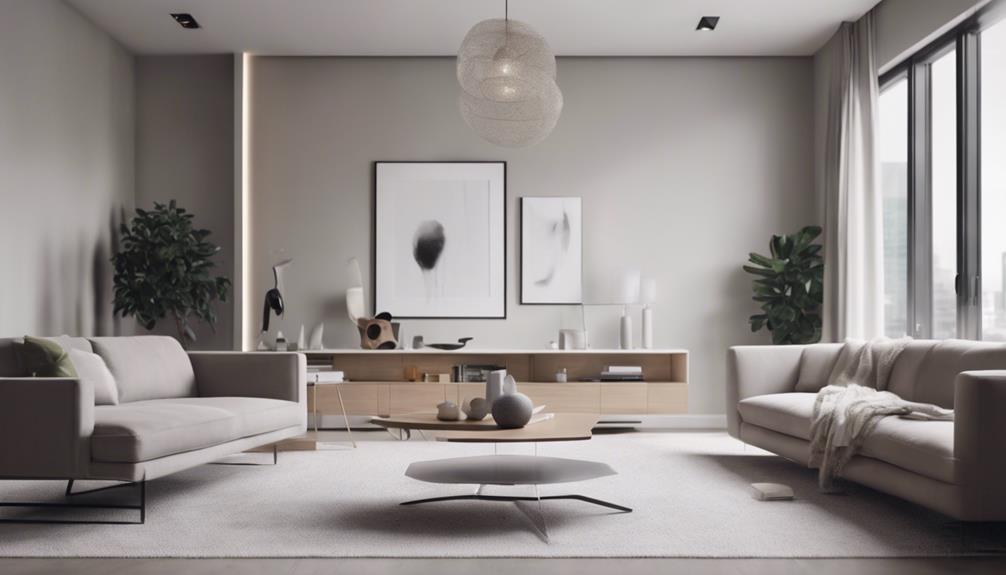
With a focus on clean color schemes and the heavy use of glass and steel, modern interior decorating styles bring a sleek and minimalist aesthetic to living spaces. These styles are influenced by German and Scandinavian design principles, emphasizing functionality over form.
Here are some key features of modern interior decorating styles:
- Minimalist design: Embracing simplicity and clean lines.
- Eco-friendly materials: Incorporating sustainable and recycled elements.
- Natural light: Maximizing the use of sunlight to create bright and airy spaces.
- Open floor plans: Removing barriers between rooms for a spacious feel.
- Contemporary design: Adapting to suit various rooms with a mix of new and old elements.
In modern interior design, the use of neutral colors with pops of vibrant accents is common, creating a harmonious and modern atmosphere. By blending these elements, modern interior decorating styles offer a fresh and sophisticated look to any home.
Industrial Interior Decorating Styles
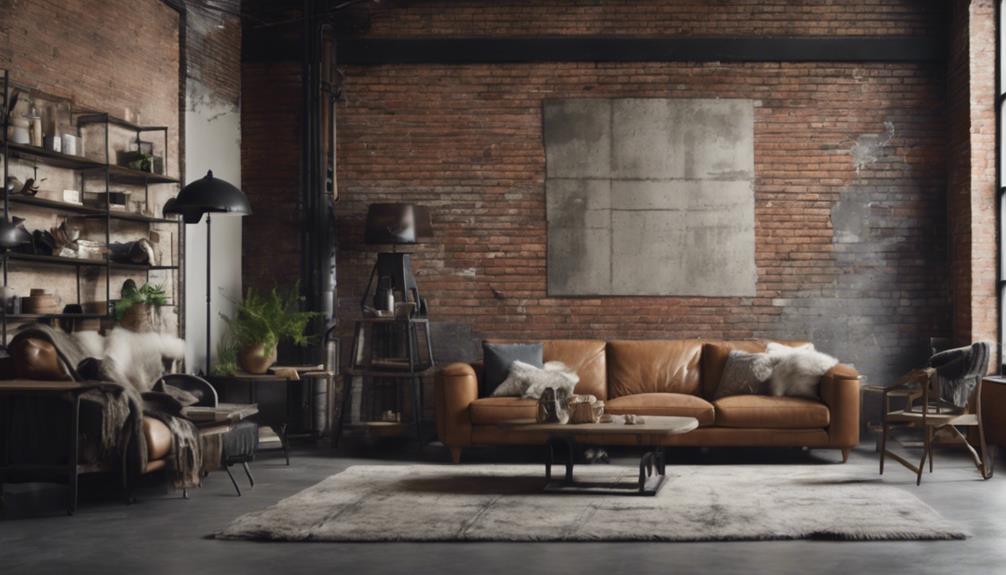
Drawing inspiration from old factories and industrial spaces, the industrial interior decorating style utilizes raw materials like metal and wood to create a rugged, unfinished aesthetic. Exposed brick walls, pipes, and ductwork are common industrial elements that add to the utilitarian vibe of the space.
Salvaged and repurposed items are often incorporated into industrial decor, giving it a unique and environmentally conscious touch. The unfinished look of industrial interior design embraces imperfections and celebrates the beauty of raw materials. The use of rugged aesthetics such as distressed furniture and vintage lighting fixtures further enhances the industrial charm.
Minimalist Interior Decorating Styles
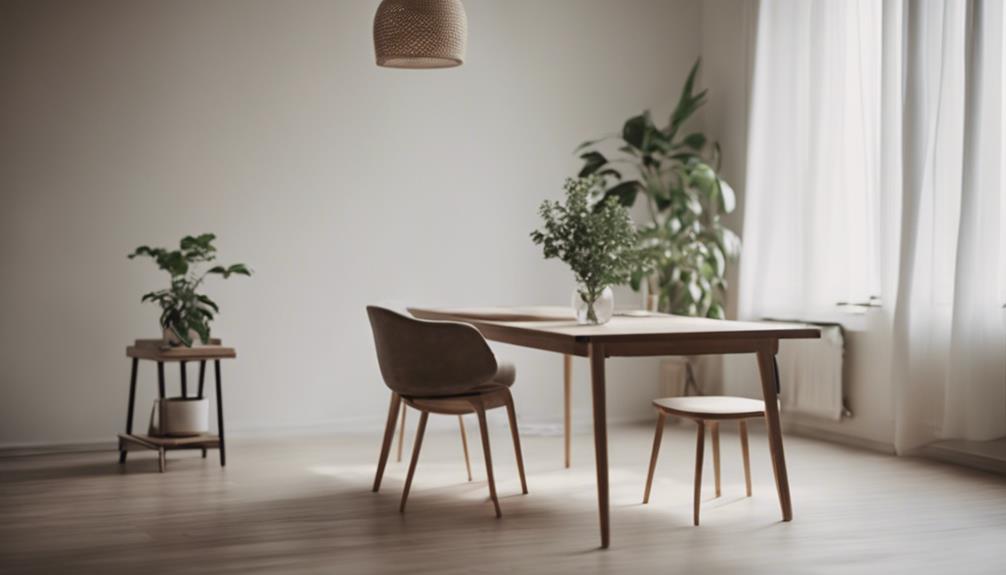
Embracing simplicity and clean lines, minimalist interior decorating styles prioritize a decluttered aesthetic and a neutral color palette. When delving into minimalist interior design, one can expect a focus on functionality, natural materials, and creating a serene atmosphere. Here are some key features of minimalist interior decorating styles:
- Neutral Color Palette: Minimalist interiors often feature a neutral color palette, such as whites, grays, and beiges, to create a sense of calm and openness.
- Natural Materials: The use of natural materials like wood and stone is common in minimalist design, adding warmth and texture to the space.
- Functionality: Functionality is a central aspect of minimalist interior design, with a focus on practicality and purposeful furniture arrangements.
- Decluttered Aesthetic: Minimalist spaces are characterized by a lack of clutter, with an emphasis on clean, unobstructed lines and surfaces.
- Serene Atmosphere: By incorporating these elements, minimalist interiors aim to create a serene and harmonious atmosphere that promotes relaxation and mindfulness.
Bohemian Interior Decorating Styles
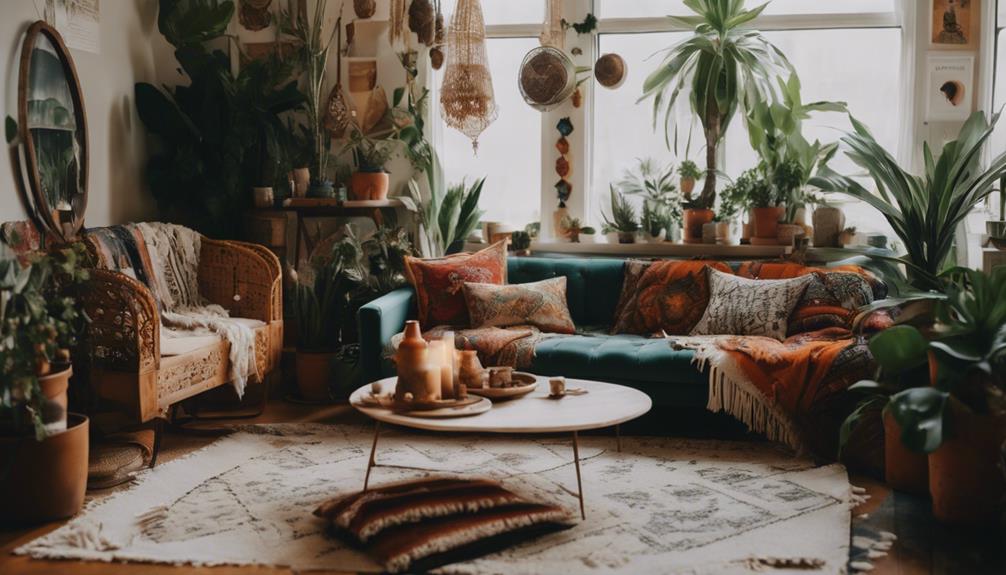
When considering Bohemian interior decorating styles, it's important to explore Bohemian color palettes, eclectic furniture choices, and the use of textiles and patterns.
These elements play a key role in creating the eclectic and vibrant atmosphere that characterizes Bohemian design. By incorporating a mix of bold colors, unique furniture pieces, and layered textiles, one can achieve the carefree and personalized look that defines Bohemian interior decorating.
Bohemian Color Palettes
Incorporating vibrant and rich hues like deep purples and burnt oranges, Bohemian color palettes are known for their eclectic mix of warm, bold colors and textures, creating a vibrant and free-spirited look. When diving into Bohemian color schemes, you'll encounter a delightful array of hues and tones that evoke a sense of creativity and whimsy. Here are some key elements to inspire your Bohemian color palette:
- Jewel tones: Deep, luxurious colors like emerald green and sapphire blue.
- Earthy tones: Warm, natural shades such as terracotta and mustard yellow.
- Soft pastels: Delicate hues like blush pink and mint green for a touch of whimsical charm.
- Eclectic patterns: Mix and match various prints and textures for a boho-chic vibe.
- Free-spiritedness: Embrace the freedom to experiment and blend colors that reflect your unique style.
Eclectic Furniture Choices
Eclectic furniture choices in Bohemian interior decorating styles seamlessly blend different periods and styles to create a unique and character-filled space. This style embraces quirky and one-of-a-kind furniture pieces that add personality and charm.
Vintage, handmade, and globally inspired furniture selections are commonly incorporated to achieve a curated look that reflects individuality. Mixing bold colors and patterns with unconventional furniture choices is key to nailing the bohemian interior decorating style.
Textile and Patterns
Embracing a mix of textures, patterns, and colors, Bohemian interior decorating style creates a free-spirited and eclectic look. Textiles play an essential role in bohemian decor, with richly patterned rugs, tapestries, and fabrics adding warmth and visual interest.
Layering different patterns like geometric prints, floral designs, and ethnic motifs is a common practice, enhancing the bohemian aesthetic. Global influences are a hallmark of this style, as elements such as Moroccan lanterns, Indian textiles, and African masks infuse cultural flair into the space.
Farmhouse Interior Decorating Styles
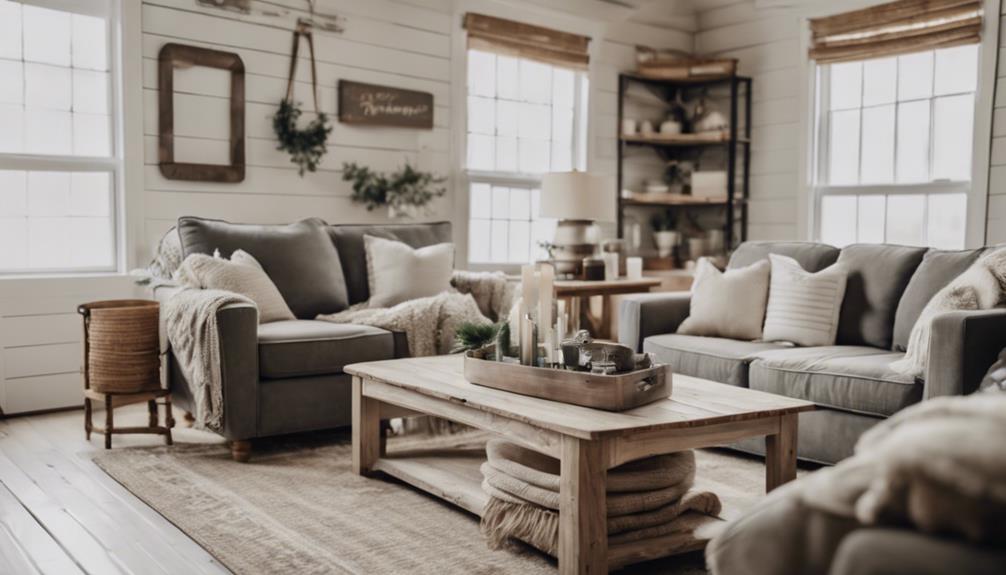
Farmhouse interior decorating styles embrace a rustic and cozy design aesthetic, often incorporating reclaimed wood and vintage decor elements to create a warm and inviting atmosphere. Neutral color palettes with warm tones are commonly used, adding to the overall cozy feel of the space. Practical and functional furniture choices are emphasized in farmhouse interior design, blending style with usability. Family-centric design elements play a significant role, focusing on comfort and creating a sense of home for all who enter.
| Farmhouse Interior Decorating Styles | Description |
|---|---|
| Rustic Interior Design | Embraces a cozy and warm aesthetic |
| Reclaimed Wood | Utilized to add character and history to spaces |
| Vintage Decor Elements | Infuse spaces with a sense of nostalgia |
| Cozy Design Aesthetic | Creates a welcoming and comfortable environment |
Coastal Interior Decorating Styles
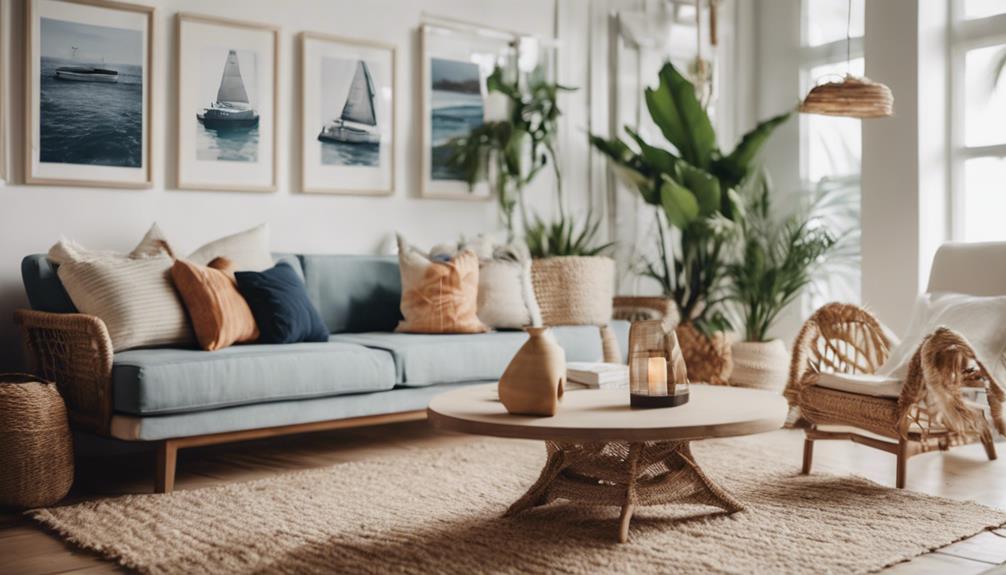
Let's start exploring coastal interior decorating styles with a focus on beach-inspired color palettes, nautical decor elements, and seaside furniture choices.
These elements come together to create a light and airy ambiance that reflects the relaxed feel of coastal living.
Beach-Inspired Color Palettes
Drawing inspiration from the serene coastal landscapes, beach-inspired color palettes play a central role in defining the essence of coastal interior decorating styles. Coastal interior design embraces light and airy color schemes that reflect the natural hues of the beach. Incorporating these calming colors helps to create a relaxed atmosphere reminiscent of seaside living. The use of beach-inspired color palettes is a key element in bringing the coastal vibe into your home. By choosing colors that mimic the ocean, sand, and sky, you can evoke the tranquility of the beach right in your living space.
- Beach-inspired color palettes
- Natural materials
- Light and airy ambiance
- Relaxed atmosphere
- Seaside living
Nautical Decor Elements
When exploring coastal interior decorating styles, one can't overlook the charm and character that nautical decor elements bring to a space. Coastal interior design often embraces a seaside vibe through the use of light and airy color palettes inspired by beach and ocean hues.
Natural materials like rattan, driftwood, and seagrass are key elements in creating a relaxed and breezy atmosphere. Maritime artwork, striped patterns, and the incorporation of nautical motifs such as shells and starfish further enhance the coastal aesthetic.
These elements come together to evoke a sense of being by the sea, making the space feel tranquil and inviting. Whether it's ropes, sails, anchors, or weathered wood, nautical decor adds a touch of maritime charm to any coastal-inspired setting.
Seaside Furniture Choices
Seaside furniture choices in coastal interior decorating styles often feature weathered wood, light fabrics, and casual, comfortable pieces to create a relaxed and inviting coastal vibe. When selecting furniture for seaside interiors, consider the following:
- Opt for weathered wood pieces to bring a touch of natural texture to the space.
- Choose light fabrics in shades of white, blue, or sandy beige to enhance the airy coastal feel.
- Incorporate casual furniture such as overstuffed sofas and armchairs for a laid-back atmosphere.
- Look for pieces that evoke a sense of the beach, like driftwood coffee tables or rope-accented chairs.
- Keep the overall design simple and uncluttered to maintain the coastal vibe of the space.
Eclectic Interior Decorating Styles
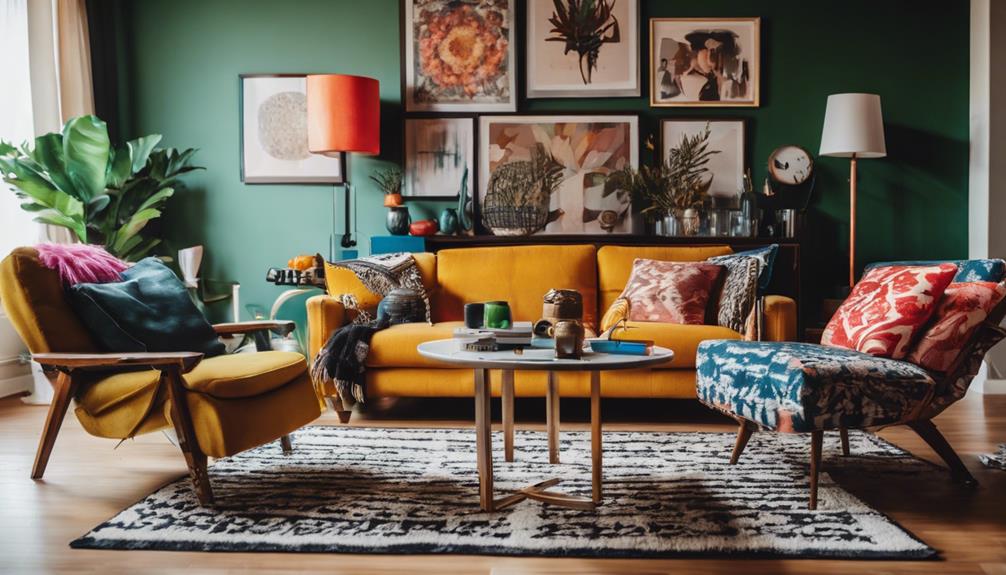
In eclectic interior decorating styles, a vibrant fusion of different design elements and eras creates a unique and personalized aesthetic. This style is all about being unique, quirky, and unconventional, blending diverse elements to achieve a visually stimulating environment that showcases individuality and creativity. Eclectic interior design allows for a high level of customization, enabling personal expression through the combination of old and new pieces.
| Key Aspects of Eclectic Interior Decorating |
|---|
| Unique and personalized aesthetic |
| Quirky and unconventional decor pieces |
| Blend of diverse elements |
Contemporary Interior Decorating Styles
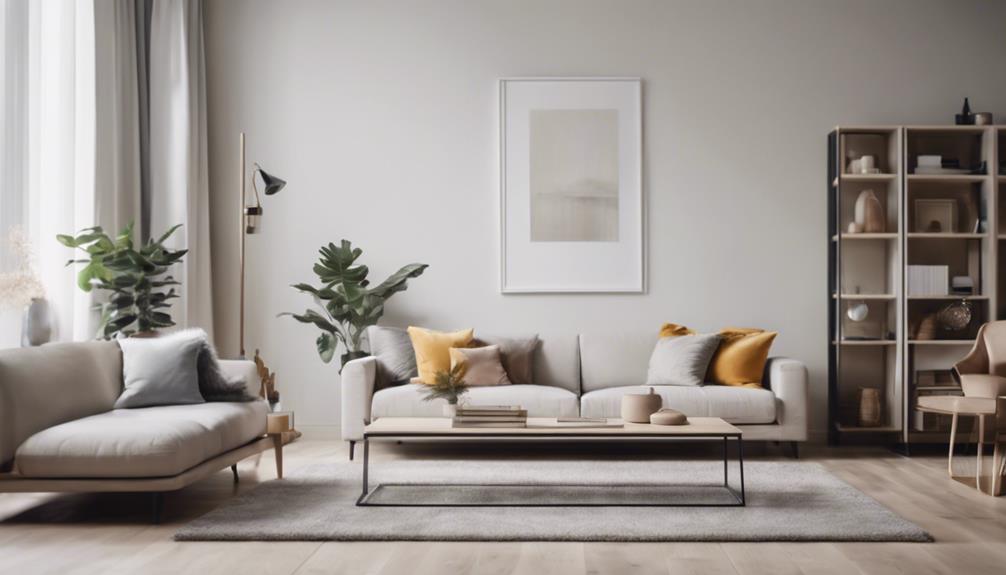
Contemporary interior decorating styles emphasize the use of open floor plans and natural light to create modern and inviting living spaces. When incorporating the contemporary interior design style into your home, consider the following key elements:
- Utilizing eco-friendly and recycled materials for a sustainable approach.
- Opting for neutral colors with pops of vibrant accents to add interest.
- Mixing new and old elements to add depth and character to the space.
- Ensuring adaptability to different rooms in the house for a cohesive look.
- Creating a harmonious balance between functionality and aesthetics.
Frequently Asked Questions
What Are the 7 Concepts of Interior Design?
The 7 concepts of interior design encompass unity, balance, rhythm, emphasis, scale, proportion, and harmony.
Unity guarantees elements work together harmoniously, while balance deals with visual weight distribution.
Rhythm adds movement and interest, emphasizing focal points for impact.
Scale and proportion play roles in size relationships, and harmony brings a cohesive feel.
Understanding these concepts is essential for creating well-designed and visually appealing interiors.
What Style of Decorating Is Most Popular?
Modern and contemporary interior decorating styles are currently the most favored choices. Traditional decor remains a timeless classic, while eclectic styles are gaining popularity for their unique appeal.
Blended decorating, which combines modern and traditional elements, is also a popular choice for its balanced design approach. Each style offers a different aesthetic, allowing homeowners to choose based on personal preferences and design trends.
How Many Types of Interior Designs Are There?
There are numerous types of interior design styles, ranging from Modern and Traditional to Boho and Organic Modern.
Each style brings its unique characteristics, like clean lines and neutral color palettes in Modern design, heritage and symmetry in Traditional design, and a layered look with bright colors in Boho design.
Different elements, such as rustic and refined mix in Modern Farmhouse style and luxe textiles in Glam style, add depth to the designs.
What Are the Three Basics of Decorating?
When it comes to decorating, the three basics we need to focus on are color, furniture, and accessories. These elements are essential in creating a cohesive and well-designed space.
Color sets the mood, furniture impacts functionality and style, and accessories add personality and visual interest.
Conclusion
To sum up, there are various types of interior decorating styles to choose from, each with its own unique characteristics and aesthetics. Whether you prefer the traditional warmth of farmhouse decor or the sleek lines of modern design, there's a style to suit every taste and preference.
By understanding the different types of interior decorating, you can create a space that reflects your personality and brings joy and comfort to your home. Start exploring and experimenting with different styles to find the one that speaks to you the most.
Wall Art and Decor
Is It Easy to Paint Interior Doors
Nail your interior door painting project with these easy steps for a flawless finish – find out how!
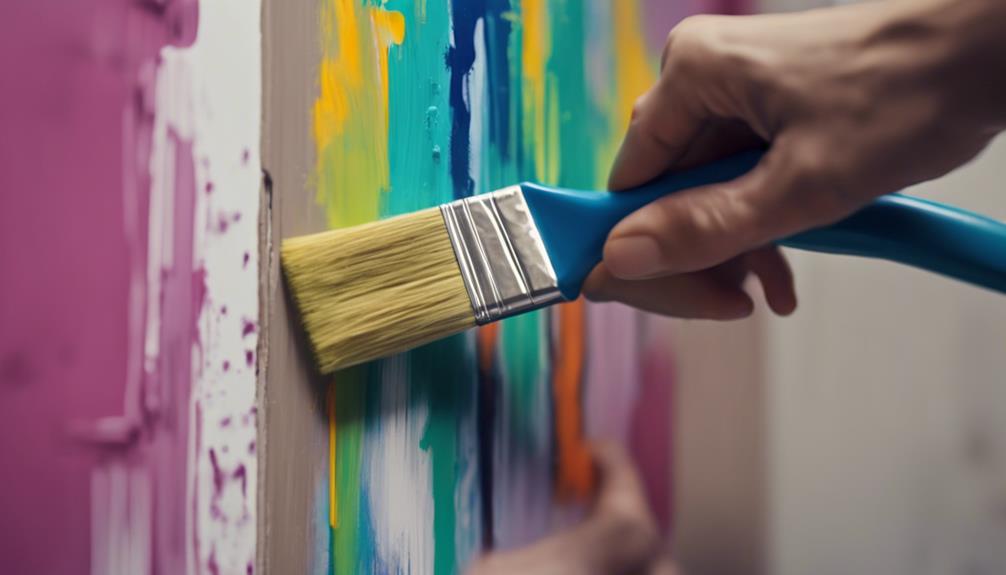
Painting interior doors is relatively easy and cost-effective, offering a way to spruce up your space. You'll need tools like paintbrushes, rollers, and sandpaper. Prep by removing knobs, filling imperfections, and sanding with 120-grit paper. Priming after sanding guarantees a smooth finish and enhances paint adhesion. Choose paint colors that complement your trim and apply multiple thin coats for a professional look. Use long, even strokes and allow each coat to dry thoroughly. For more tips on painting interior doors, discover techniques and tools for a flawless finish.
Key Takeaways
- Painting interior doors is easy with proper tools and techniques.
- Prepping, sanding, priming, and choosing paint color are key steps.
- Using quality tools and materials ensures a professional finish.
- Following step-by-step instructions simplifies the painting process.
- Practice and patience lead to successful interior door painting.
Benefits of Painting Interior Doors
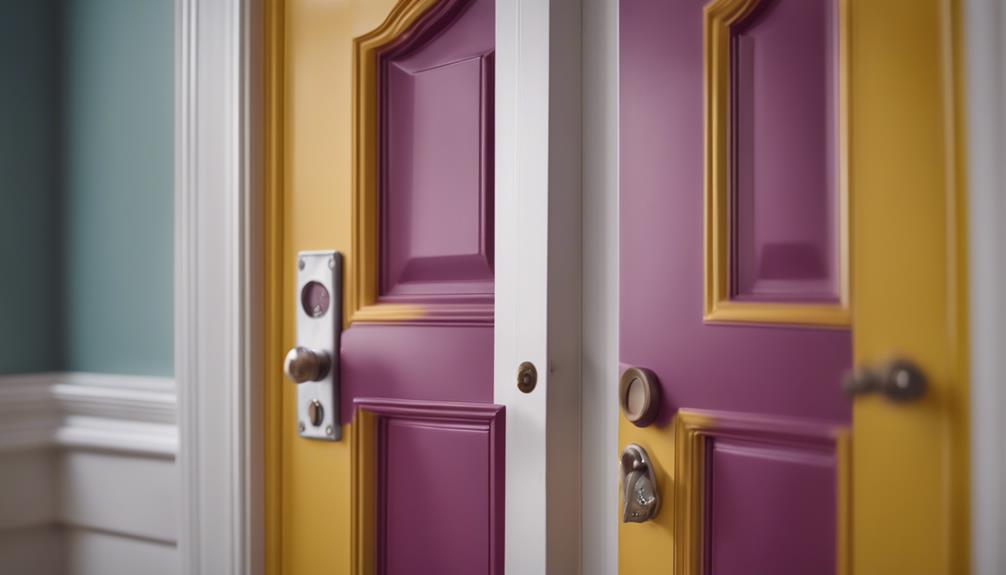
Painting your interior doors can quickly revitalize the ambiance of any room in your home. The color scheme you choose for your doors can greatly impact the overall aesthetic of your living space.
By updating the paint on your interior doors, you can easily customize and personalize your home without breaking the bank. Applying a coat of primer before painting will help the new color adhere better and last longer.
When painting, use a high-quality brush for the edges and a roller for the flat surfaces to guarantee a smooth finish. Opt for latex paint, as it dries quickly and is easy to clean up.
Make sure to paint not only the door but also the door frame for a cohesive look. Well-painted interior doors can tie together the design scheme of your home, creating a sense of harmony and cohesion throughout the space.
Necessary Tools for Door Painting
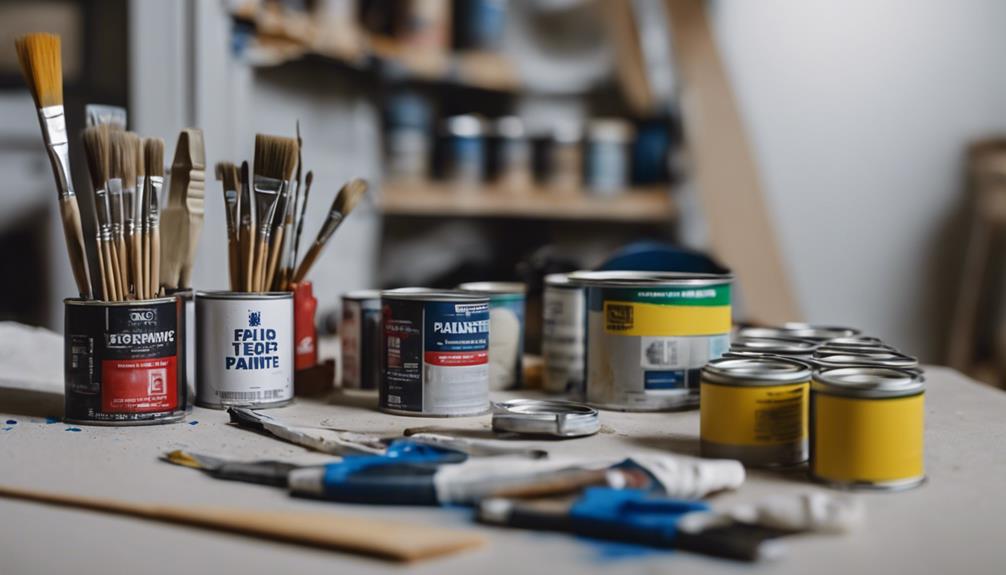
Updating the paint on your interior doors can be made easier with the right tools at your disposal. Essential tools for painting your doors include paintbrushes, rollers, painter's tape, sandpaper, and a drop cloth to protect your floors.
A high-quality paint pail will make the painting process smoother, while using wood shims can provide stability when painting. A utility knife is handy for precise cutting and trimming. Consider using a brush with a magnet to tackle intricate areas and door hardware with accuracy.
After use, wrap your tools in Saran Wrap to maintain their condition and prevent dried paint buildup. Remember, investing in durable door hardware from reputable suppliers can enhance the quality and longevity of your painted doors. Having these tools ready will ensure a successful door painting project.
Prepping Your Interior Doors
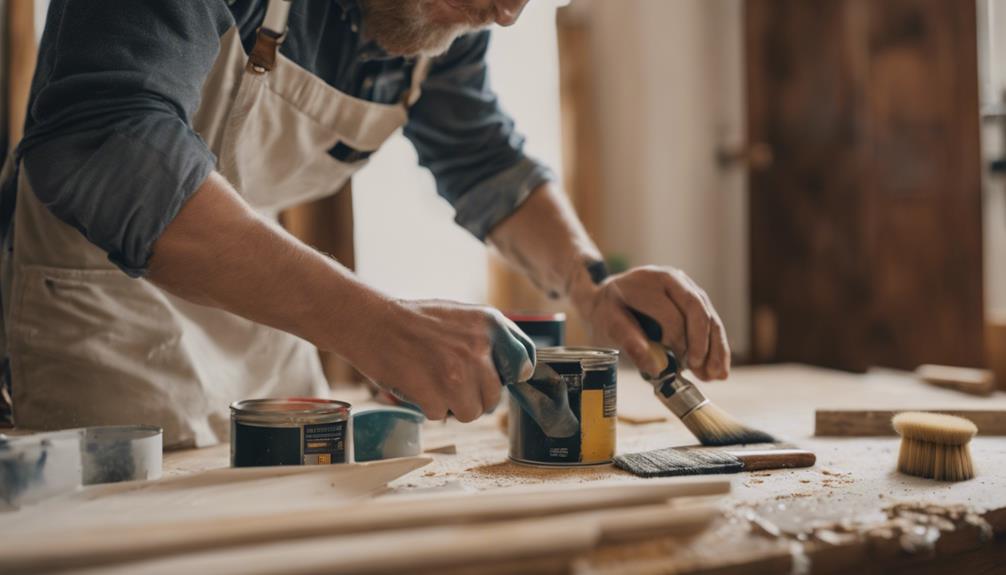
To prep your interior doors for painting, start by removing or taping off any knobs. Fill in any imperfections with wood filler and sand the surface with 120-grit sandpaper for a smooth finish.
Cleaning the door with a degreasing cleaner will guarantee the paint adheres well for long-lasting results.
Sanding for Smooth Finish
Before applying paint to your interior doors, ensure a smooth finish by sanding them using sandpaper with a grit of 120 or higher. Sanding is essential for prepping the surface, ensuring it's free of imperfections and creating an even surface for the paint to adhere to.
A 120-grit sandpaper or higher will help you achieve a professional-looking finish by smoothing out any rough spots. This process is vital to improving the overall quality and durability of your paint job.
Priming for Better Adhesion
After sanding your interior doors for a smooth finish, the next step is priming to enhance adhesion before painting. A primer is important for better paint adhesion to the surface. It seals the door, preventing stains from bleeding through and ensuring a smooth base for the paint.
Choosing the right primer based on the door material and paint type is necessary for best results. Skipping this step may lead to uneven coverage and poor adhesion, requiring additional coats of paint. Make sure to apply the primer evenly and allow it to dry thoroughly before painting.
This preparation step sets the foundation for a professional-looking finish on your interior doors.
Choosing the Right Paint Color
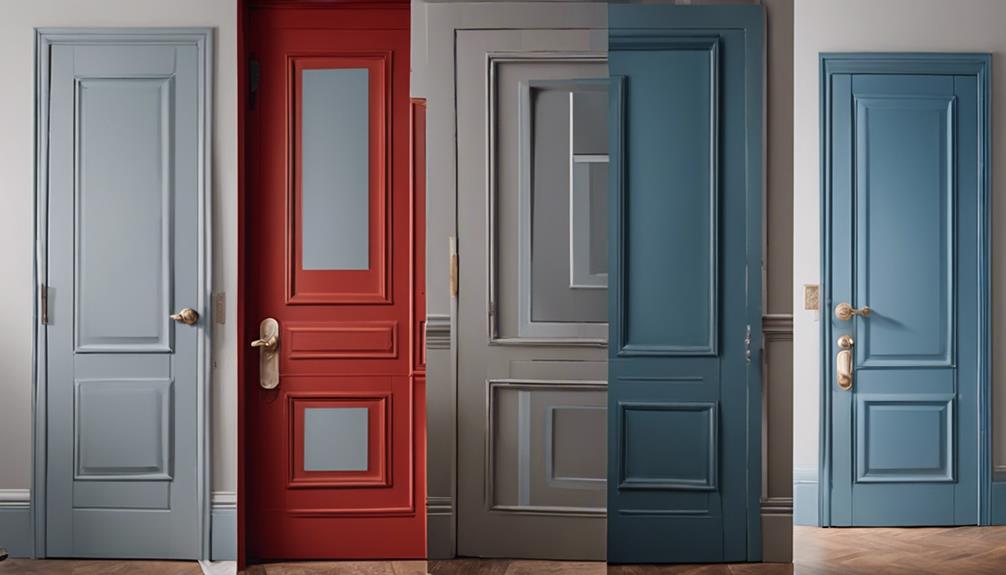
When selecting the perfect paint color for your interior doors, consider experimenting with shades that complement your existing trim for a cohesive and stylish look. Here are some tips to guide your choice:
- Consider Classic Whites: Benjamin Moore's Cloud White or Simply White in semi-gloss or satin finishes can provide a timeless appeal to your doors.
- Test in Small Areas: Before committing to a color, test it on a small area of your door to see how it interacts with the lighting in your space.
- Match Your Trim: Opt for a paint color that either matches or complements the color of your existing trim to maintain a harmonious appearance.
Customizing your door colors can help create a unique style that fits your personal taste and complements your home décor. Whether you prefer bold hues for a striking effect or muted tones for a more relaxing ambiance, the right paint color can enhance the overall look of your interior doors.
Techniques for Painting Doors
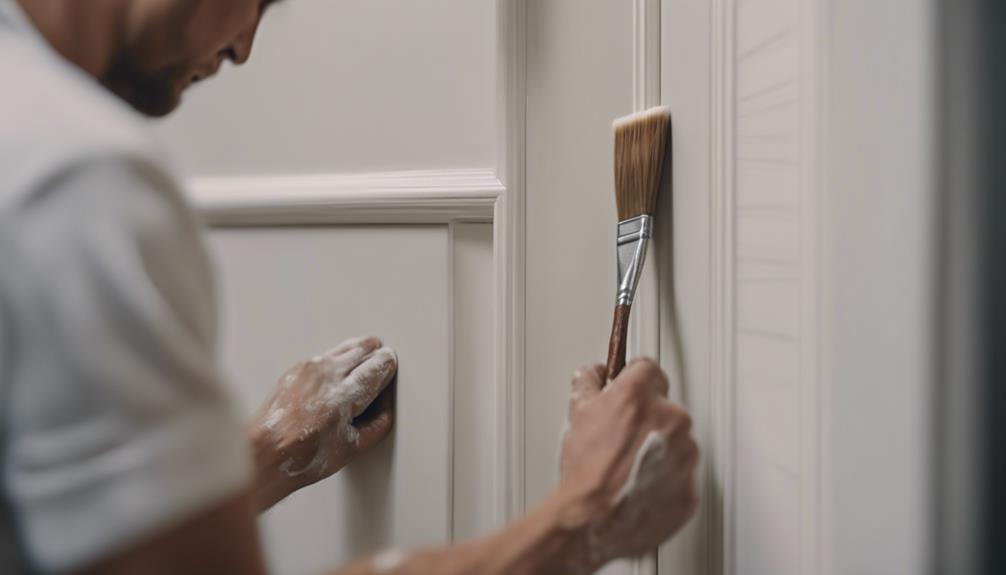
To achieve a professional finish when painting doors, use long, even strokes for best coverage. Start by applying a coat of primer to prepare the door surface.
Then, using a high-quality brush or roller, begin painting the door with latex paint. Make sure to smooth out any brush marks or roller lap marks as you go along for a polished look. It's best to apply multiple thin coats of paint rather than one thick coat to guarantee better coverage and a smoother finish.
Consider adding a paint additive to the latex paint for improved application and durability. Allow each coat of paint to dry completely before applying the next one to prevent any issues with drying time.
Tips for a Professional Finish
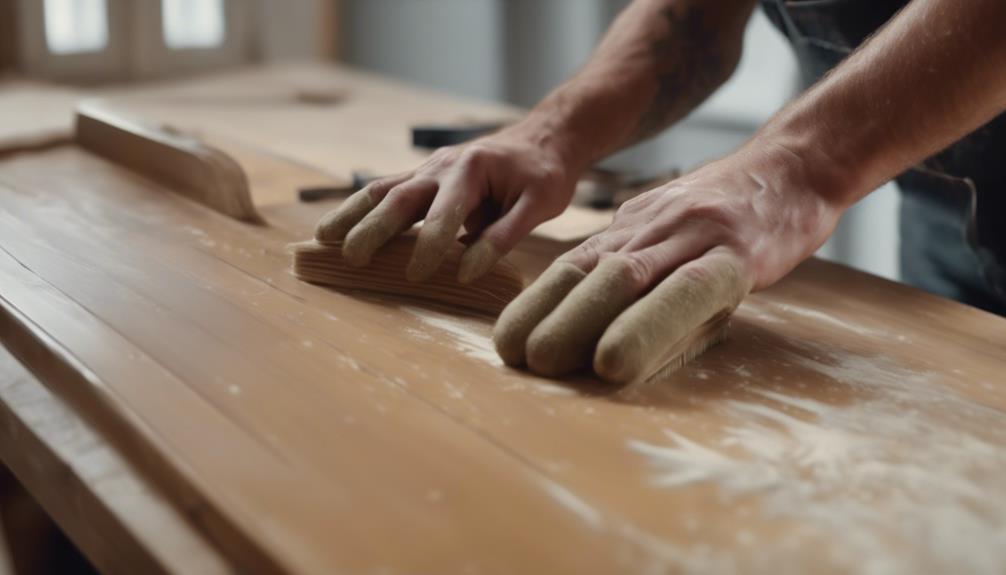
You can enhance the professional finish of your painted interior doors by paying attention to key details, such as using long, even strokes and applying multiple thin coats of paint. To achieve a flawless result, follow these tips:
- Use Long, Even Strokes: When painting your interior doors, opt for long, smooth strokes to prevent visible brush marks and guarantee a seamless finish.
- Apply Multiple Thin Coats: Rather than trying to cover the door in one thick coat, apply several thin coats of paint. This technique helps prevent drips, uneven coverage, and provides a smoother appearance.
- Smoothing Out Roller Marks: After each coat, inspect the door for roller lap marks and gently sand them down to maintain a uniform and professional look.
Frequently Asked Questions
What Is the Easiest Way to Paint Interior Doors?
To paint interior doors easily, follow these steps:
- Choose the right paint type and prep the surface.
- Use painter's tape to protect surroundings and apply primer for adhesion.
- Paint with a brush, roller, or sprayer in even strokes for a pro finish.
- Let coats dry between applications, applying multiple thin layers for full coverage.
- Keep the door in its frame to save time, starting with the frame/casing.
These steps simplify the painting process for you.
Is It a Good Idea to Paint Interior Doors?
Painting interior doors is a wise decision. It allows for personalization and can transform the aesthetic of a room. With the right color choice, you can enhance the ambiance and create a visual impact. Plus, it's a cost-effective way to update your space.
Is It Better to Paint a Door With a Brush or Roller?
When painting a door, using a brush for detailed areas and a roller for larger sections is key. Brushes offer precision for intricate designs, while rollers cover flat surfaces efficiently.
To achieve a smooth finish, consider using both tools. Applying multiple light coats with a brush or roller can help you achieve a professional look.
Do Interior Doors Need to Be Sanded Before Painting?
Yes, sanding interior doors before painting is vital. It creates a smooth surface for better paint adhesion by removing imperfections and rough areas. Properly sanded doors prevent paint from peeling and guarantee long-lasting results.
Sanding helps paint adhere evenly, reducing streaks and ensuring a professional finish. It's an essential step for achieving a flawless and durable paint job on interior doors. Sanding is key to a successful painting project.
Conclusion
So there you have it, painting interior doors may seem like a challenging task at first, but with the right tools, preparation, and techniques, it can actually be quite easy.
Just remember to choose the right paint color, prep your doors properly, and use the right painting techniques for a professional finish.
With a little patience and attention to detail, you'll have beautifully painted interior doors in no time!
Mason – Your Product Expert Mason is your go-to product expert, carefully selecting each item in our collection to ensure it meets your comfort, functionality, and style needs. With his attention to detail and commitment to quality, he ensures that every product we offer enhances your home experience.
-

 Decorative Throws2 weeks ago
Decorative Throws2 weeks agoIs It Better to Dry Clean Blankets?
-

 Yarn2 weeks ago
Yarn2 weeks agoIs Yarn Natural or Manmade? Unravel the Truth
-
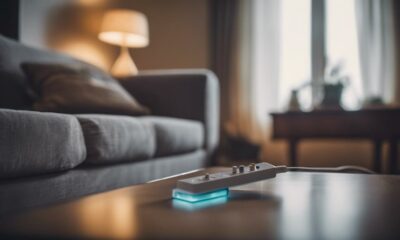
 Decorative Throws2 weeks ago
Decorative Throws2 weeks agoWhat Wattage Is an Electric Throw
-
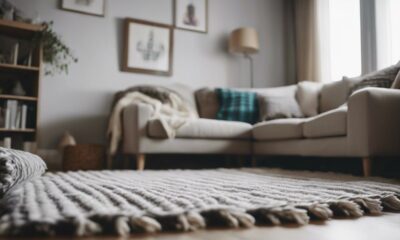
 Decorative Throws2 weeks ago
Decorative Throws2 weeks agoCan I Use a Throw Blanket as a Rug
-
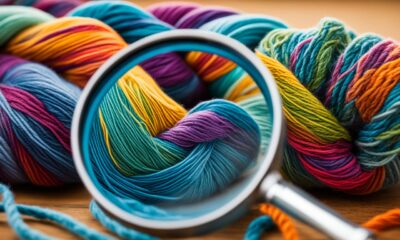
 Yarn2 weeks ago
Yarn2 weeks agoUnravel the Mystery: Why Are Yarn Specs a Secret?
-

 Craft and Textiles2 weeks ago
Craft and Textiles2 weeks ago15 Best Battery-Powered Leaf Blowers for Effortless Yard Work
-

 Tableware and Dining Accessories2 weeks ago
Tableware and Dining Accessories2 weeks agoWhat Is the Meaning of the Word Tableware
-

 Craft and Textiles2 weeks ago
Craft and Textiles2 weeks ago15 Best Toast Recipes to Start Your Day Right















